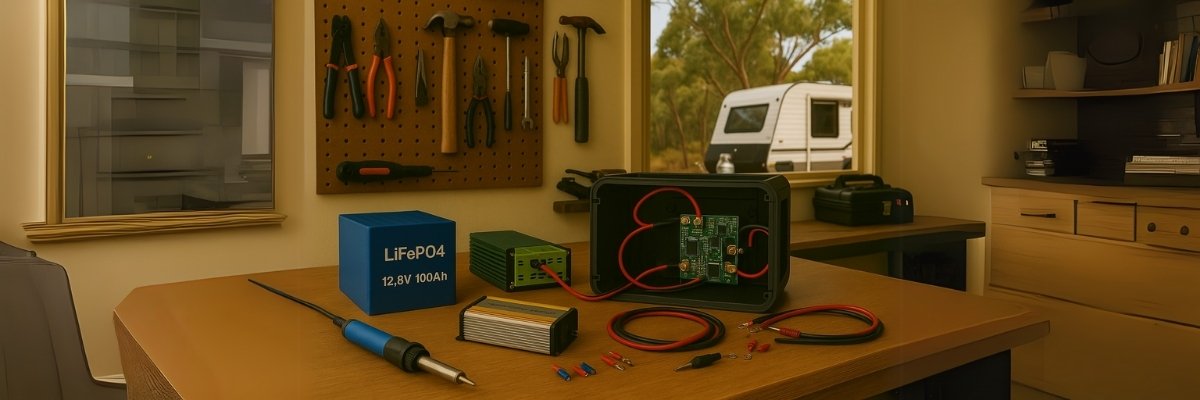
How to Build Your Own Portable Power Station?
Ever wondered how to make a portable power station perfectly tailored to your needs? Whether it’s for camping, van life, or emergency use at home, building your own homemade portable power station can save money, deepen your technical knowledge, and provide reliable off-grid energy. This guide will walk you through how to build your own portable power station—even if you don’t have access to electricity to start with.
Not sure which power station is right for you?
Take the quiz!
Why Build Your Own Portable Power Station?
Customisation and Cost Benefits
When you build your own portable power station, you get to choose the parts and features that best suit your needs. The diy power station cost is often much lower than buying a commercial unit, especially if you already have some components like batteries or an inverter on hand. It’s also a rewarding project that lets you create something truly unique, all while saving money.
Learning and Self-Reliance
Building a homemade portable power station is not just about saving money—it’s also an excellent opportunity to learn the basics of electricity, battery care, and safe wiring practices. Once you’ve built it, you’ll be able to diagnose and fix issues on your own—no more waiting for repairs or warranty claims!
What You’ll Need for a DIY Portable Power Station Kit
Battery – LiFePO4 Recommended
The heart of your diy portable power station lifepo4 build is a lithium iron phosphate (LiFePO4) battery. Known for its safety, longevity, and ability to handle deeper discharges, this type of battery is the ideal choice for a long-lasting power station. Make sure the battery comes with a Battery Management System (BMS) to protect against overcharging and overheating.
Inverter – For AC Appliances
If you want to power 240V appliances like a laptop or fan, you’ll need a pure sine wave inverter. This device converts the battery’s DC output into clean, stable AC power that’s safe for your devices.

How to Build Your Own Portable Power Station Step-by-Step
Step 1: Define Your Power Needs
Start by listing all the devices you want to power, along with their wattage and estimated usage hours. This information will help you determine the battery size and inverter capacity you’ll need. If you're unsure about the specifics, start small and scale as you go.
Step 2: Source the Right Components
It’s crucial to choose quality components from reputable suppliers. Don’t skimp on parts—using cheap batteries or low-quality inverters could pose serious safety risks, such as fires. Stick to reliable brands and check reviews before purchasing.
Step 3: Wiring and Assembly
Refer to a diy power station diagram to guide your build. Securely mount the battery, inverter, and controller. Use crimped terminals to make solid electrical connections—never use twisted wires. Always test each circuit to ensure it’s working correctly before powering up your system.
Step 4: Housing and Final Touches
For your diy power station box, repurpose an old toolbox, Pelican case, or another sturdy container. Make sure to add ventilation if necessary to avoid overheating. Clearly label inputs, outputs, and fuses, and consider installing an LCD display or voltmeter to keep track of your power levels.

Essential Tools and Skills for Building Your Own Portable Power Station
Key Skills You’ll Need
Building your own diy power station kit requires some basic understanding of DC power systems, wire polarity, and fusing. You’ll also need to be comfortable with soldering and crimping, as well as using a multimeter to troubleshoot and test connections.
How to Build Your Own Portable Power Station Without Electricity
If you’re wondering how to build your own portable power station without electricity, don’t worry. You can start by using charged batteries or solar panels as your power source. Many DIY enthusiasts successfully build off-grid systems, even in remote locations, such as their sheds or campsites!
How to Build a 12V Portable Power Box
If you’re specifically interested in building a 12v portable power box, keep your components compatible with 12V systems. These are ideal for smaller, lightweight builds that are easy to transport and perfect for camping or off-grid living.
Conclusion: Build a Portable Power Station That Works for You
Now that you know how to make a portable power station that fits your needs, budget, and style, it’s time to get started! Whether you're building a diy portable power station kit from scratch or modifying an existing setup, you’ll have the freedom to create a reliable, off-grid energy solution. Take your time, stay safe, and enjoy the satisfaction of creating something useful with your own hands—without depending on commercial options.


